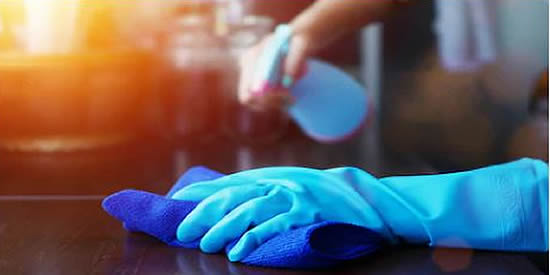Wash, Rinse, Sanitize and Disinfect for General Aviation Operations
We want to thank you for all the questions during the NBAA Webinar and for the emails that followed. Over the next couple of weeks, John and I will answer as many of the questions that were posted during the webinar as possible. As a follow up, we are focusing first on cleaning, sanitizing, and disinfecting in order to respond to the vast number of questions and requests for this type of additional information.
This pandemic has currently caused a shortage of cleaning and sanitizing supplies throughout the world. Many of the supplies are going to hospitals, restaurants, and catering companies to insure public health. A common question is, “what should I use to clean and sanitize?” John and I have provided the CDC a list of approved sanitizing chemicals that can be used to kill the virus, and other bacteria, in our resource list at the end of this article.
We are all in this storm together. We hope this information will successfully answer some of your additional questions. Please look for more information on food safety for business aviation as John and I address more of your questions and food safety related topics.Proper Techniques for Cleaning, Sanitizing, and Disinfecting
Each of the three featured procedures vary in purpose and must be used in proper order, to be most effective.
Cleaning
Cleaning is simply removing debris, dust, and any foreign matter from a surface. Cleaning is done by using hot water and soap to remove the dirt, soil and food off the surface. You must clean before you sanitize anything. Technically speaking, you can clean something without it being sanitized, but not the other way around. What needs to be cleaned?
-
The refrigerator at the hanger, FBO, breakroom and at home. Cleaning and organizing the refrigeration unit should occur when there is debris, drips or old food remains. If the refrigerator is used frequently, cleaning should take place on daily basis
- The hanger/FBO/ office ice machine should be cleaned and sanitized at least once every six months for efficient operation. First, you must perform a cleaning procedure to remove lime, scale, and mineral deposits; followed by the sanitizing procedure to disinfect the unit and remove algae, slime, and mold spores. Pay special attention to mold around the gasket seal, and inside the door. Make sure the ice scoop is hanging on the outside in a ventilated wire holder and that the barrel of the scoop is facing down to drain residual water off the scoop. The ice scoop should never be stored inside the ice machine, and the scoop end should never be touched by a bare hand. Under no circumstance should the ice machine be used to chill food or beverages.
- Dishwasher detergents are designed for cleaning, but they do little in the way of truly “cleaning” your appliance. Little bits of food, soap scum and grease will cling together, buildup and become the ideal breeding ground for various microorganisms. Your dishwasher should be cleaned regularly around the drain basket where food debris catches and does not go down the drain or into a disposal that some machines have. Clean the filter. Not all dishwashers have them, but if your dishwasher has a filter, remove and throw away anything trapped inside. Lots of old gross food likes to hide in there. It can also become a veritable breeding ground for old food residue, grease and all other disgusting stuff. Just because the dishwasher ran, DOES NOT mean it is clean of food debris and is sanitized.
A side note about dishwashers:
In commercial establishments, when using a commercial dish machine, most dish cleaning solutions contain Hydrogen peroxide and other chemicals to sanitize everything that goes through the machine. These chemicals, when used properly, are safe for food service areas. Many caterers also use food contact service wipes as well throughout the kitchen and are also great for galley areas as well. When you hand off your dishes to the handler/FBO to be cleaned, you assume that their dishwashers are cleaning and sanitizing your equipment. Many of the industrial dishwashers are also high temp dishwashers in which a water heater booster brings the water up to 170 ° F/77°C to sanitize the equipment. Many home dishwashers, flight department and FBO dishwashers do not generally sanitize… they clean. Regular dish detergent does not have sanitizing chemicals in them, and those that do, would most likely be washed away before the rinse cycle. There are some new home machines that do sanitize, but they only bring the water temperature up to 150°F/65.5°C with a heating coil. Most newer dishwashers that have a sanitizing feature use an extended hot-water rinse to kill germs. The National Sanitation Foundation has set a standard called NSF/ANSI Standard 184, which means that dishwashers bearing this certification kill 99.99 percent of bacteria when operated on the "sanitize" setting.

- Your counters and other surfaces - At the hangar, on board the aircraft, everywhere… (think ‘touch points’- counters, faucets, drawer pulls or pressure points, window shades, call buttons, seat belts, tables, chairs), the lav, the galley, FBO food areas and home kitchens should be cleaned daily at the very least followed by a sanitizing procedure. I look for fingerprints on light switches, woodwork, handles, surfaces to find my first areas to clean and sanitize, moving outward from the dirty touch points. Be aware that certain cleaning and sanitizing supplies, unless aircraft approved by OEM’s may damage and/or fog the interior finishes of the aircraft.
- Your galley/kitchen sink and other kitchen equipment. Your sink can be a cesspool of bacteria, virus, and parasites. It is a breeding ground that is often overlooked. A great way to bring a stainless sink back to life is to place vinegar-soaked paper towels over the interior surface and allow to sit for several hours if possible. This will pull old residue out of the fine brush marks and “use scratches” natural to stainless. The FBO’s that have popcorn machines, microwaves, cookie ovens and accessory pans, coffee stations for clients should consider cleaning and sanitizing these areas and equipment as well. Refrigerator and microwave handles are also hot spots that require regular cleaning and sanitizing.
A note concerning another often overlooked item: your cutting board. Studies show that 200 times more fecal bacteria lives on the average cutting board than on the top of the toilet seat.
- The facility coffee pots: Each time you use your coffee maker, you should wash and rinse the pot and filter. This will help remove any bacteria that may build up in the coffee pot and will ensure that your coffee tastes fresh. Clean out the water reservoir and the spout where the coffee comes out. You should break down, clean, and decalcify the entire coffee maker once every three months or more often if used frequently.
The coffee pot handle in a shared kitchen was the most commonly contaminated site as reported in a study by University of Arizona.
- Now, let’s talk sponges . . . and cloth dish towels. ICK! (for lack of a more technical term.) About 15 percent of kitchen sponges contain bacteria - like salmonella and E. coli. How often should you clean and sanitize your sponges in the kitchen sink? Every day or every other day. One way to disinfect a kitchen sponge is to heat it in the microwave -- but be sure to do it safely, and never microwave a sponge containing metal! While most germs can only survive about 30 seconds in the microwave, you'll need to nuke your kitchen sponge for two minutes at full power to eliminate E. coli. However, a recent study found that the strongest and worst bacteria might survive the nuking. Instead, you could run the sponge through the washing machine at the hottest setting using detergent and bleach or, better yet, replace it weekly or use it in a less germ-sensitive place, like the bathroom. And the unfortunate news about the kitchen or galley dish towel . . . A new study suggests that your dish towels are crawling with bacteria that can potentially cause food poisoning and other foodborne illnesses. Researchers from the University of Mauritius cultured 100 multiuse kitchen towels after one month of use, without washing. They found that nearly half tested positive for bacterial growth - most of which originated from human intestines. Of the 49 samples that tested positive, 36.7 percent grew coliform bacteria, 36.7 percent grew Enterococcus, and 14.3 percent grew Staphylococcus aureus (S. aureus).
If you must use a multi-use dish towel, start by swapping out your towels daily. The absence of pathogens from single-use towels suggests that proper hygiene practices could play a huge role in preventing the growth of harmful bacteria.
- Linens - As far as linens and bedding go, Amanda Kraft, co-owner of Airware had this to say, “You should avoid shaking out the laundry, whether jet bedding, pillow, blankets, linen napkins, table runners, and even placemats, as it can spread the virus through the air. One of the best things you can do to protect yourself is to wear rubber gloves when handling soiled laundry.” Many of us want to use Oxygen-based bleaches (OxiClean, Clorox 2, OXOBrite are brand names) but they do not provide disinfectant qualities when used in the laundry processes. It has been proven that the extreme temperatures of steam pressing clothes kill germs, allergens, and bacteria when linens and bedding are professionally cleaned/dry cleaned. The high heat steaming procedures that the dry-cleaning companies use are the safest way to get rid of nasty bacteria from all your fabrics. This process doesn’t just kill sickness-related germs but also successfully attacks odor-causing bacteria and allergens.
If laundering at the hangar or at home, do the laundry frequently. Remember most viruses can live on clothing and fabrics up to 3 days. Read the label and wash using the highest heat recommended to achieve the best disinfecting results. Running the drying cycle for at least 28 minutes is also an effective way to kill viruses.
Try using one (or all) of these household products for a strong and effective sanitation for your laundry:
- Bleach - Add ½ cup once the wash cycle has started. You should use color-safe bleach for any dyed fabrics, and chlorine bleach for white bedding and linens; BUT READ THE CARE INSTRUCTIONS FIRST
- Hydrogen peroxide - Unlike chlorine bleach, hydrogen peroxide is safe for most fabrics and dyes. Add 1 cup of this antiseptic oxidizer to your wash. Note: you should still spot test to make sure it doesn’t cause discoloration.
- Borax - Add ½ cup to your wash. Borax does all kinds of good things for your laundry. It increases stain-removal, neutralizes odors, and disinfects extremely well.
Sanitizing vs Disinfecting vs Sterilizing
So . . . the process starts with cleaning, which must be done first. Because if you do not remove the dirt and then you sanitize, it will give the surface bacteria a chance to grow on areas where a virus can live.
According to the CDC, sanitizing is generally a little more gentle than disinfecting. While sanitizing refers to lowering the number of germs to a safe level by either cleaning or disinfecting, disinfecting itself refers to killing nearly 100 percent of germs on surfaces or objects. So, simply put, sanitizing is the removal of most contaminants that grow bacteria which will affect your health. Disinfecting is eliminating the invisible microorganisms that are harmful to someone’s health.
Sterilizing, on the other hand, is the complete destruction of all microorganisms from a surface. Disinfection and sterilization are both decontamination processes. While disinfection is the process of eliminating or reducing harmful microorganisms, sterilization is the process of killing all microorganisms.
Most foodservice facilities use a variety of sanitizing chemicals that are safe for food production equipment and services. The most common is Quaternary ammonium, or Quats, and is used in kitchen sanitizing buckets and other areas throughout the kitchen. The negative side of this product is that it must airdry on the surface when applied. There are some other products that are both approved by the Environmental Protection Agency (EPA) and the Food and Drug Administration (FDA). Generally, the FDA regulates and approves products that are applied to the skin. The EPA regulates and approves products for use in our homes/offices or our environment. According to Annie Balshi, CEO of B.E. Princess “Our new line of antimicrobial products, is an FDA-cleared product that uses the identical Hypochlorous chemistry, certified by EPA to kill COVID-19.” So, even though the labels are FDA approved, they are identical to what the EPA says kills 99.9% of germs on hard surfaces. Annie also states: “On March 3, 2020 this product was placed on the EPA’s list of Approved disinfectants to kill the novel coronavirus, Covid-19. Hypochlorous (HOCL) is a powerful antimicrobial agent occurring naturally in our body and produced within our white blood cells to combat infection. Because of its germ-killing strength and unique safety profile, it is the perfect weapon against germs, both on surfaces and skin. The company has developed Hypochlorous for everyday use. We have increased our inventory of all these products, as well as any other items needed during this pandemic.” B.E.Princess offers their products, under two labels: EPA Surface Disinfection and FDA Skin Cleansing.
Now using a proper food safe sanitizing or any sanitizing agent you must follow the instruction as each has what type of surface it can used for and the contact time that it needs to have to be affective. To sanitize you must take the appropriate steps to ensure that you have the proper contact time for it to work. The majority of sanitizing agents will need to let the item air dry as well. You should never dry the items with a dish cloth.

Don’t be a Scientist at home
Too many of us think we are scientists and will mix bleach and water, alcohol and water, or worse mixing other items you are not familiar with. Avoid mixing bleach or alcohol with other liquids as many of these concoctions are potentially dangerous. This is a huge risk factor as too much of an ingredient like this can cause a chemical contamination, get someone really sick, and even kill them.
We have heard from some people, while at home, have used a mixture of bleach and water for sanitizing by mixing a cup of bleach in a bottle and adding water. Technically, the correct amount is 4 tsp per quart of water. Again, this type of mixture is very dangerous and should only be used as a last resort. Also, this solution must be wiped off after use or you may cause a chemical reaction.
Never be a Scientist On Your Aircraft
When we teach food safety classes, we always recommend using items that are made for what you are cleaning and sanitizing. NEVER be a chemist when sanitizing your aircraft! “Items such as rubbing alcohol and bleach are included in the 49 CFR 175 regulations for Hazardous Materials and Dangerous Goods. There are basically three generalized categories that the nine main Hazmat classifications for air transport fall under; those that are accepted, forbidden, or restricted (with proper amount/quantity and containment). Although rubbing alcohol is allowed, bleach is forbidden,” says Scott Arnold, trainDAVINCI Subject Matter Expert.
Yes, bleach may be great for cleaning your bathroom at home but not for an aircraft. Using bleach can become a maintenance nightmare if used in your aircraft’s lavatory. The main concern about utilizing chlorine bleach is the potential to cause damage to seals and (if equipped) the vacuum system itself by way of stripping the protective layer(s) of these items. In addition, if chlorine bleach is mixed with your lavatory’s "blue juice," not only could you be filling your cabin with toxic fumes, but you could be mixing two oxidizing agents - very dangerous!
See also:
Aviation Catering today, tomorrow, and when the COVID19 virus threat is mitigated
Resources:
B.E. Princess
Chemicals and cleaning supplies, cabin snacks, beverages and more.
Annie Balshi, CEO, www.BEPrincess.com
Airware
Packaging, China, silver, crystal, Linens:
Amanda and Eric Posey, Owners, www.myairware.com
EPA approved list:
https://www.epa.gov/pesticide-registration/list-n-disinfectants-use-against-sars-cov-2
NBAA Webinar: COVID-19 Reinforces the Need for Catering Best Practices
An NBAA News Hour webinar held on April 7 provided best practices for pilots, flight attendants, FBO personnel and everyone else in the supply chain of aircraft catering during the COVID-19 crisis. https://nbaa.org/aircraft-operations/safety/coronavirus/covid-19-reinforces-the-need-for-catering-best-practices/
| © BlueSky Business Aviation News Ltd 2008-2020 |



